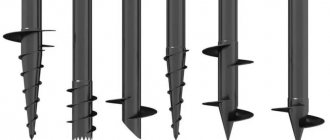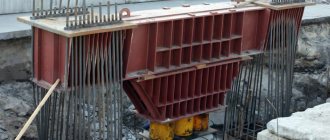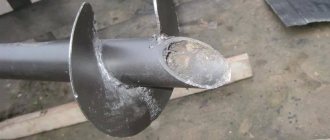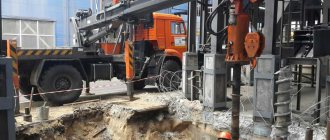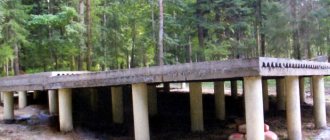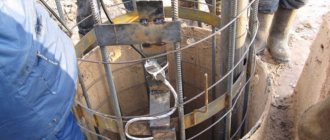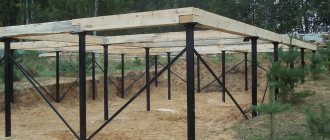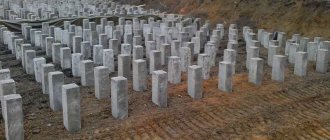Construction of a secant pile
The main difference between a bored secant pile and a bored pile is a continuous installation with partial overlap and alternate reinforcement.
Fig. 1 : Construction of a secant pile
A secant pile is created by using a casing with a detachable shoe base. Its interior is filled with concrete mixture, after which the casing is removed.
Expert advice! Reinforcement of secant piles with a three-dimensional frame occurs one at a time. The pile is created directly in the well without the use of impact force. In some cases, vibration may be used.
The main advantage of secant piles is the ability to create them directly on the construction site. In appearance, ready-made secant piles look like a monolithic solid wall. Thus, high strength and complete protection from the penetration of groundwater is achieved.
Areas of use:
- Fixing underground structures;
- Strengthening buildings under construction with ground and underground floors;
- Protection of emergency buildings;
- Construction of metro lines;
- Construction of enclosing walls of river canals;
- Base for strip foundation;
- Densely built areas with weak loamy or clayey soil;
- Hydrogeological function, that is, protection of underground buildings from erosion by groundwater;
- Use in hydraulic facilities. Construction of secant pile foundations for dams for various purposes;
- Use in industrial facilities. Fencing of underground chemical, oil refining and metallurgical slag dumps to prevent the leakage of hazardous substances with groundwater.
The standard diameter of bored secant piles is sixty-two and seventy-five centimeters. When installed, the footage between the centers of each pile should reach ninety percent of the main diameter of the pile shaft.
Rice. 2 : Bored secant piles (diagram)
When constructing massive structures, it is necessary to use reinforced concrete piles with a length of ten meters. Smaller pile pillars are intended for light and medium-sized buildings.
Expert advice! The depth of the drilled secant pile must be greater than the groundwater level in order to avoid undermining the structure being constructed from below. Also, before starting construction, it is necessary to conduct a chemical analysis of the water to determine its aggressiveness to the concrete mixture.
Bored secant and tangential piles: characteristics and technologies
Burosecating and drilling tangential piles
Today they are quite often used in the construction of certain underground structures.
Burosecating piles are an analogue of a well-known method in construction called “soil wall”. Such piles are a kind of modification of the long-known bored piles. The diameter of bored secant piles can vary from 350 mm to 750 mm. In this case, the distance between the centers should be equal to 0.8-0.9 of their diameter. Reinforcement of such piles occurs one at a time.
Bored secant piles can be used as combined or strip structures, which can be enclosing or load-bearing. Such piles are used for fencing pits, provided that sufficiently airtight walls are needed.
The use of bored secant and bored tangential piles is an ideal solution when the device is made in soils that are characterized by the presence of a fairly large amount of groundwater. These piles are also indispensable when it is necessary to isolate them from water, and in addition they are often used to fence pits.
There are various methods for constructing piles of this type, but their choice directly depends on the geological conditions of the construction site, as well as the economic feasibility of a particular method. The type of foundation chosen, the type of pile and the design of the building's foundation directly depend on the conditions expected at the construction site.
The technology of bored secant piles involves the use of various casing pipes during work, the length of which varies between 1-3 meters. If you do not plan to use pipes, you can replace them with a through auger. It is planned to install a cutting tip, which is placed in the first section (lower flange) of the casing pipe. During drilling, the casing pipe must continuously perform reciprocating movements.
The type of drilling tool directly depends on the type of soil on which bored piles are required. Drilling a well must be completed by installing a special reinforcement cage, and only after this can the wells be filled with concrete, for which special inventory concrete pipes are used. At the end the casing pipes must be removed.
The difference between bored secant piles and bored piles
Bored secant piles are a variant of bored piles. The manufacturing technology is similar, the conditions of use are the same: both are used in areas where ground vibration cannot be allowed.
Bored piles: used for constructing foundations, located at standard distances from one another, all reinforced (see more about bored piles)
Brown secants: perform the function of a monolithic enclosing wall; they are installed in a continuous pattern, partially overlapping each other. Not every pile is equipped with a reinforcing frame, only one at a time.
If necessary, drilling is carried out using casing pipes: their function is to prevent the well from collapsing and deforming the soil.
Methods for expanding the bottom of a drilled well
The wide bottom support of the bored pile gives it stability and strength.
This extension is done in several ways. The main method is mechanical. This expansion at the base is made with a special drill with a special device.
These are blades at the end of a special drill. At a given depth, the blades open. The process of opening the blades is controlled by the operator.
Another method of expanding the lower cavity of a well is explosion. The explosive is dropped there. The casing pipe is filled with concrete solution up to two meters high.
After the concrete hardens, the pipe rises fifty centimeters upward. And the explosive device is set off. A spherical cavity is formed in the ground, which is filled with solution.
Bored secant pile technology
In an earthen section, secant piles look like a solid wall. The parameters of their location and depth must be carefully calculated in the project.
Rice. 3 : Bored secant piles (type of foundation)
The process of creating bored secant piles:
- Intelligence service . Conducting geological research to draw up a map indicating the direction and depth of groundwater. Taking samples of water droplets for chemical analysis to determine the degree of aggressiveness to the concrete mixture.
- Wells . According to the design data, vertical tunnels are drilled at control points using casing pipes. Their depth and total area of location will depend on the design of the building and the level of groundwater passage.
- Well testing . Next, the bottom of the pipe is checked for leaks. If there is no groundwater, workers move on to the next stage.
- Concrete injection . The sealed casing pipe is filled with concrete mortar.
- Extract . Without waiting for the concrete mixture to harden, the pipe is unscrewed from the well. The lower shoe tip, under the pressure of a large mass of concrete, breaks off and remains inside. And the concrete solution fills the entire hollow space of the well.
- Standing . All wells filled with concrete, but not reinforced, must harden well. The result is concrete piles.
- Installation of the frame . Vibrating units are used to immerse the volumetric frame into the filled well. The frame can also be installed in the casing before concrete is poured directly. Drilling to install a reinforced pile is carried out by affecting adjacent piles.
- Rearrangement . Relocation of construction equipment units to the next control point.
Upon completion of installation work for installing bored secant piles, they are connected along the upper level with a reinforced concrete belt. It gives additional strength and overall completeness to the appearance of the foundation.
Rice. 4 : Scheme of a foundation made of secant piles
Advantages of secant piles
In practice, secant piles, the construction technology of which is gentle, can work perfectly in residential areas, and even in the immediate vicinity of buildings, since the secant structure has minimal impact on the strength of the soil. Pouring concrete into a well minimizes the risk of horizontal soil movements and preserves the load-bearing characteristics of the soil.
The technology for constructing bored secant piles is often used not only in the construction of foundations, but also as a finished load-bearing wall of a construction site. Therefore, calculation of the cost of work shows the high efficiency of the method at low costs, ensuring high strength of any structure.
Double Rotary Technology
The Double Rotary method involves the use of two rotational elements, one of which, the upper auger, is hollow inside. The mobile drilling rig drills a well while simultaneously rotating the casing pipe counterclockwise using the lower holder. It follows that the casing pipe rings the well before groundwater enters it. The concrete mixture hardens under the best conditions and the resulting concrete is of high quality. Consequently, secant piles form an absolutely waterproof wall against groundwater.
Expert advice! Using Double Rotary technology, the pile is immersed to a depth of up to twenty-two meters with a diameter of one hundred and two centimeters. The overall inclination of the well walls is practically absent. Also, on soft soils, when concrete is supplied under pressure, the final density of the pile column increases.
Advantages of Double Rotary technology:
- Application on different soils;
- High productivity, consisting of installing twenty-four piles per shift;
- The accuracy of the location of secant piles is checked by an on-board computer;
- Supply of concrete mass under pressure, which guarantees high-quality filling of the tunnel.
Technological stages of construction of the structure
After carrying out preparatory activities with clearing the work site, the following operations are performed:
Wells are drilled at control points. Casing pipes are immersed in them and the structure is strengthened. The lower part of the pipe is checked for leaks. An indicator of reliability will be the absence of groundwater in the shoe. Filling with concrete. Using a concrete mixing machine hose, the solution is poured pointwise into the niche of the casing pipe. Also, the technology for installing bored secant piles provides for the possibility of immersing a reinforcing frame. This should be done before the mixture hardens. Removing the supporting structure. The casing is lifted by crane after the first signs of hardening
It is important that the solution does not crystallize completely, otherwise the pipe will not be removed. Standing
Formation of concrete piles with strength gain. Strapping. After installing a group of piles, they are tied with a reinforcing metal belt.
Calculation of the bearing capacity of a wall made of secant piles
The bearing capacity depends on the geological features of the work site.
There are two formulas.
- If the ends of the piles rest on rocky soil:
N = (or<) Yc/4YkYg x Rc.n. x A (Id/Df + a)
Yc – coefficient. working conditions of the pile, accepted 1
Yk – coefficient reliability of the foundation (accepted 1.4)
Yg – coefficient reliability of the soil under the pile (1.4)
Rc.n. – ultimate uniaxial compressive strength of soil in a water-saturated state
A – pile support area
Id – depth of embedment in the ground (for less than half a meter it is taken equal to 0)
Df – diameter of the pile embedded in the ground
a – when Id is less than half a meter, 1.5 is accepted, in other cases 0
- If the ends of the piles rest on compressible soil (non-rock):
N = (or<) Yc/Yk x (Ycr RA + U ∑ Ycf FiHi)
Ycr – coefficient soil work for sandy and clayey soils under the pile – 1
R – calculated soil resistance, taken from the table (for example, with an average clay soil of 0.3 and a pile depth of 5 m it will be equal to 650 kPa)
U – perimeter of the pile section
Ycf – coefficient. soil performance on the sides of the pile, depends on the drilling and concreting methods, taken from the table (for clays, regardless of water content - 0.6, for other rocks in dry conditions - 0.7, under water - 0.6)
Fi – calculated soil resistance on the sides of the pile (for clay 0.3 at a 5-meter well depth – 40)
Hi – soil thickness on the sides of the pile
The remaining values are the same as in the formula for rock support.
Calculation of secant piles
At the project development stage, the chief engineer must determine the number and parameters of the piles used. The initial data comprises a wide range of indicators from soil type to external operating conditions. On average, it is believed that a monolithic enclosing structure around the perimeter of a pit can withstand about 100 tons. The bearing capacity of one secant pile with a diameter of 150-200 mm on medium-density sandy soil is more than 1000 kg. In other words, for a building with an average load, 80-100 piles will be enough. The final figures will be influenced by other parameters - for example, soil resistance, determined based on the results of geodetic studies. For example, on clay soil, when the pile is buried 5 m, the load will be 650 kPa. From here you can determine the optimal diameter and area of the base (shoe) of the pile. So, a thickness of 200 mm will correspond to an optimal area of 300-320 cm2.
Advantages of secant technology
The production of secant piles has more advantages in comparison with other types and technologies for creating pile supports.
- Accuracy . The technology of bored secant piles allows installation in dense urban environments using a minimum of construction requirements.
- Silence . The work carried out does not create noise or vibration background.
- Safety . There is no need to worry about violating the integrity of nearby foundation supports.
- Compactness . Production of bored secant piles directly on the construction site.
- No overspending . Minimum excess of the specified amount of concrete mixture.
- Economical . There are no costs for disposal of construction waste.
- Any soil . Application on various types of soil, ranging from loose sandy soils.
